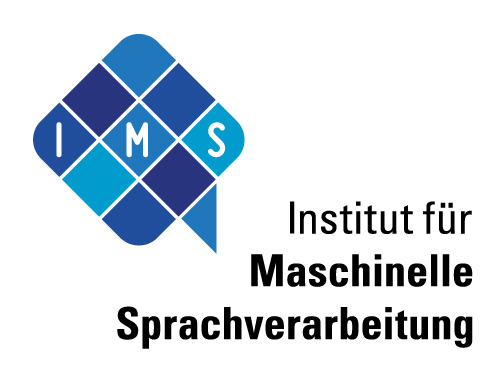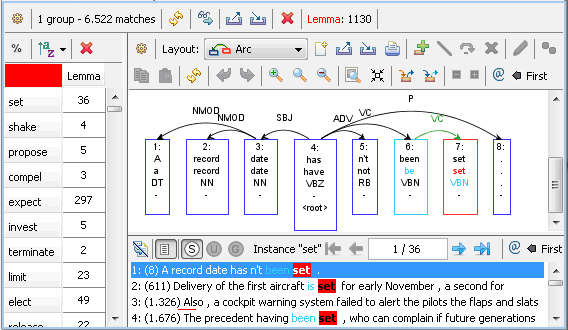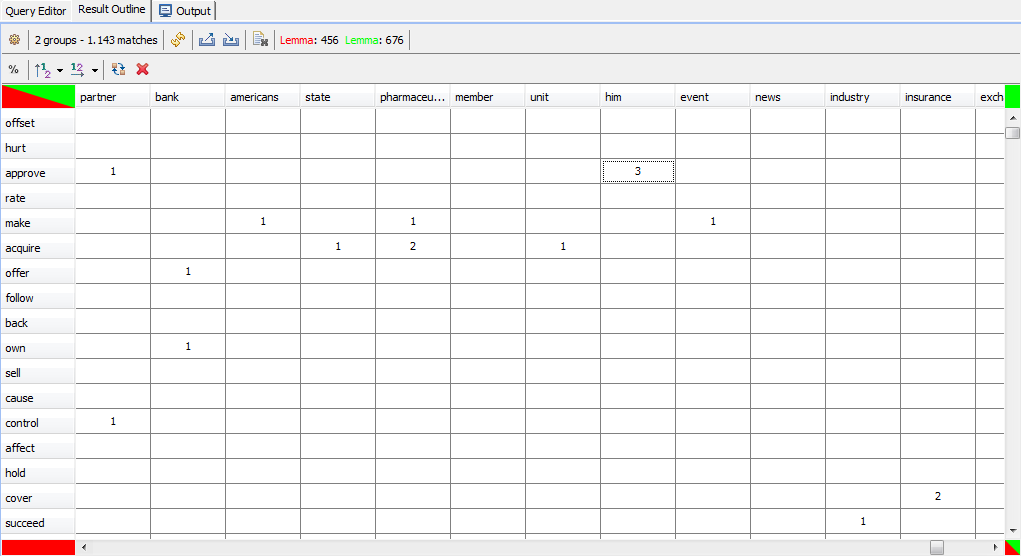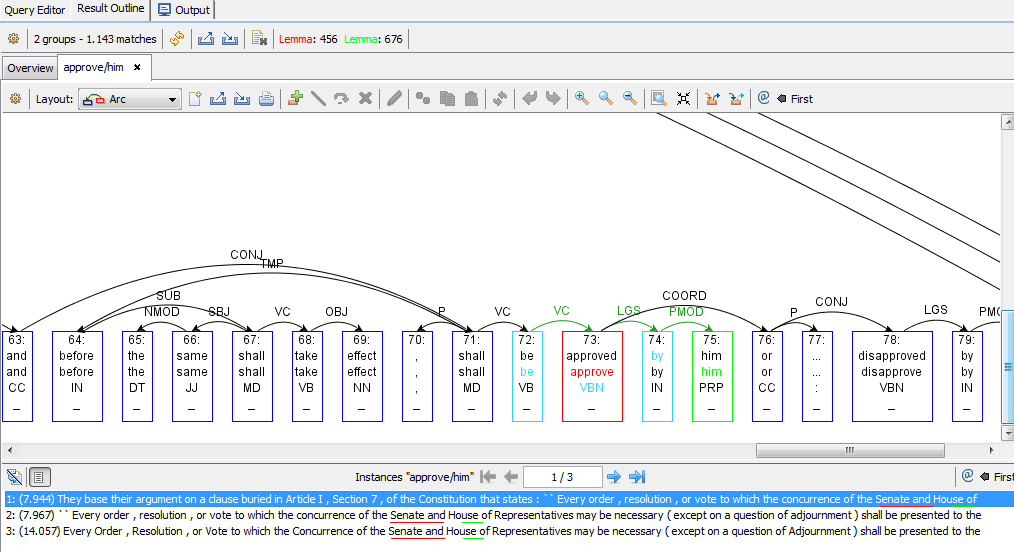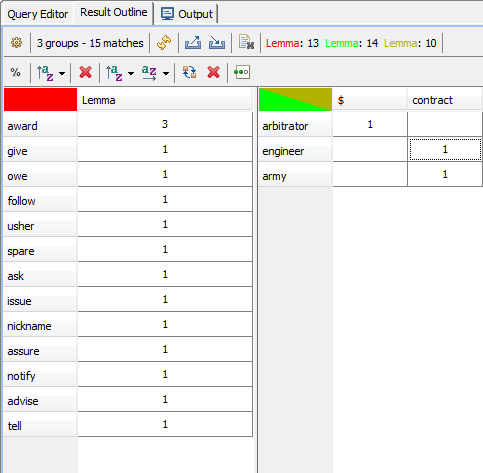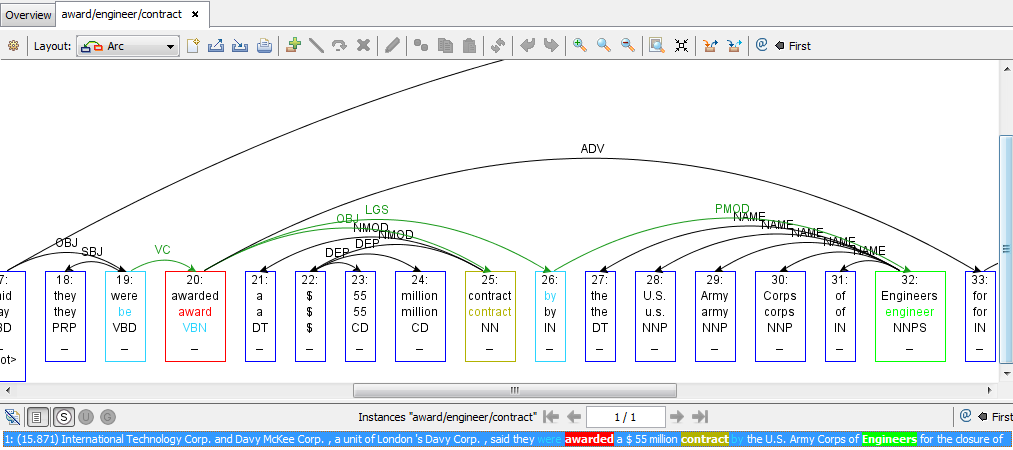|
Size: 8252
Comment:
|
Size: 9723
Comment:
|
| Deletions are marked like this. | Additions are marked like this. |
| Line 28: | Line 28: |
| Line 35: | Line 36: |
=====Search Menu: ===== {{attachment:search_manager_menu.png}} * {{attachment:search_preferences.png}} * {{attachment:search_new.png}} = Create a new search * {{attachment:search_execute.png}} = Executes the search. Note if no data-set was set the button is disabled {{attachment:search_execute_inactive.png}} Search History Toolbar: {{attachment:search_history-tb.png}}. Every executed search is listed in the search history. The history is available until you close your ICARUS session. In this example we have three search history items. During the search process the icons to the left may change: * {{attachment:search_runing+loading.png}} Search is active (first icon) but the target data-set is not loaded yet (second icon) * {{attachment:search_runing+loaded.png}} Search is active (first icon) and target data-set is loaded (second icon) * {{attachment:search_finished+loaded.png}} Search finished successful (first icon) and target data-set is loaded (second icon) * {{attachment:search_icon_error.png}} Search was not successful. * {{attachment:search_clearhistory.png}} = Clear all search history items * {{attachment:search_remove1search.png}} = Remove the selected search result from the history * {{attachment:search_viewquery.png}} = Display the query of the selected search * {{attachment:search_inspect.png}} = Display the result of selected search * {{attachment:search_cancel.png}} Cancel selected search |
ICARUS-Search-Perspective
The  perspective provides the following search types:
perspective provides the following search types:
- Dependency-Search
- * Coreference-Documents
* ErrorMining for Part-Of-Speech Tags
* ErrorMining for Dependency Structure
- * under development will be available soon
How to set up a new search:
Click on
 to create a new search.
to create a new search. - Afterwards the search need to be configured:

- Type: Select one of the following search types described above.
- Data-Set: The Treebank/Document used for the query.
Query: Clicking
 opens the query editor. There may be different types of query editors depending on the search type.
opens the query editor. There may be different types of query editors depending on the search type. - Parameters: Search pararameters depending on the search type.
Execute Search using the
 button
button View the Result by double-clicking the search result or use the inspect-button

Search Parameters (Dependency-Search):
- Search-Mode: Non-Exhaustive (stop after first hit), Exhaustive (add each sentence to the result at most one) and Exhaustive search with Grouping
- Direction: Left-To-Right or Right-To-Left
- Case-Sensitiv: On/Off
- Result Limit: limit the search result (number of hits)
Result View (Dependency-Search):
- Aggregated result visualization depending on the number of grouping operators (dimensions) for up to three groups (3D)
- Result highlighting for instances of query constraints
- Fully customizable graph visualization
- Easy navigation through results for up to three groups (3D)
=====Search Menu: =====


 = Create a new search
= Create a new search  = Executes the search. Note if no data-set was set the button is disabled
= Executes the search. Note if no data-set was set the button is disabled 
Search History Toolbar:  . Every executed search is listed in the search history. The history is available until you close your ICARUS session. In this example we have three search history items. During the search process the icons to the left may change:
. Every executed search is listed in the search history. The history is available until you close your ICARUS session. In this example we have three search history items. During the search process the icons to the left may change:
 Search is active (first icon) but the target data-set is not loaded yet (second icon)
Search is active (first icon) but the target data-set is not loaded yet (second icon)  Search is active (first icon) and target data-set is loaded (second icon)
Search is active (first icon) and target data-set is loaded (second icon)  Search finished successful (first icon) and target data-set is loaded (second icon)
Search finished successful (first icon) and target data-set is loaded (second icon)  Search was not successful.
Search was not successful.  = Clear all search history items
= Clear all search history items  = Remove the selected search result from the history
= Remove the selected search result from the history  = Display the query of the selected search
= Display the query of the selected search  = Display the result of selected search
= Display the result of selected search  Cancel selected search
Cancel selected search
1) Tutorial Dependency Search (passive constructions) with one grouping operator:
If the the user doesn't exactly know the how passive constructions are annotated in a treebank. Then he can use e.g. mate-tools or weblicht to parse a sentence contains a passice construction and copy&paste the structure to the search graph.
Parsed sentence "Mary was kissed by a boy."
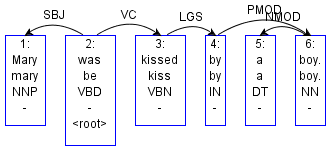 .
. Select the passice construction
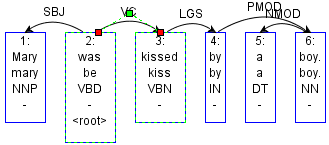
Copy the selected cells and edges
 and switch to the
and switch to the 
Paste selected cells and edges into the search query editor window

The resulting graph when using the arc-layout (recommended)

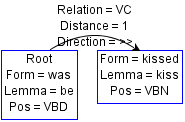
- In the following step the search graph (query) will be generalized (double clicking the edge / nodes to open the edge/node editor).
Node 1
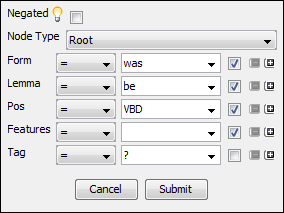 changed to
changed to 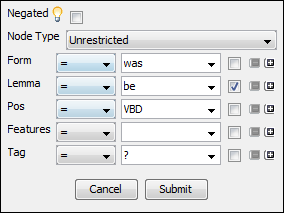
Edge
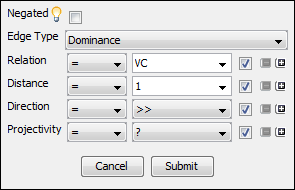 changed to
changed to 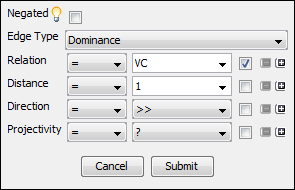
Node 2
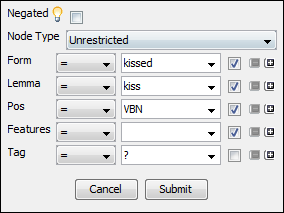 changed to (added grouping operator <*>)
changed to (added grouping operator <*>) 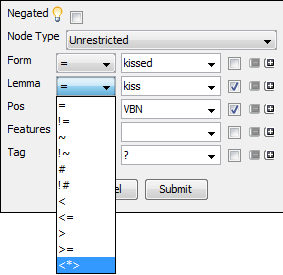
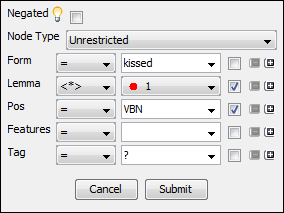
These changes result in a new more generalized version of the search graph (below is the textual query representation)
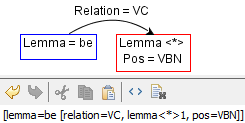 This query matches passive constructions in English as annotated in the CoNLL08 Shared Task data set.
This query matches passive constructions in English as annotated in the CoNLL08 Shared Task data set.
2) Tutorial Dependency Search (passive constructions with overt logical subjects):
We are interested in passive constructions with overt logical subjects, grouped by lemma of the verb and the lemma of the logical subject. We may use the search graph for passive constructions or build the query completly manually (shown here).
First of all clear the graph editor panel (if there is any remaining graph) using

Add four new nodes
 you may "automatic reorder" them by clicking
you may "automatic reorder" them by clicking 
Your graph editor should look like

- There are two ways connecting nodes / adding edges
Select two nodes
 and connect them clicking on
and connect them clicking on 
Place the cursor in the middle of the desired (source) node. A green border will show up
 . Hold the left mousebutton and move to the (target) node. When you reached the target node again a green border shows up. Release the left mousebutton to draw an edge between those node
. Hold the left mousebutton and move to the (target) node. When you reached the target node again a green border shows up. Release the left mousebutton to draw an edge between those node 
Double click on the nodes/edges to specify the constraints. (Note: Adding constraints may mess up the graph layout. You may use
 to redraw the graph)
to redraw the graph) Node 1: Lemma = be

Node 2: Lemma = <*> (red grouping operator); Part-Of-Speech = VBN

Node 3: Form = by

Node 4: Lemma = <*> (green grouping operator)

Edge 1: Relation = VC

Edge 2: Relation = LGS

Edge 3: Relation = PMOD

When every node, edge was linked and there was no error setting the constraints above the search graph should look like this:

(Textual query: [lemma=be [relation=VC, lemma<*>1, pos=VBN [relation=LGS, form=by [relation=PMOD, lemma<*>2]]]])
3) Tutorial Dependency Search (passive constructions with overt logical subjects and object):
In tutorial 1) we showed how to create a query using a copied graph from the parser. Tutorial 2) shows how to create a query from scratch. In tutorial 3) we will extend the search graph used in 2) with an additional grouping operator.
We start with the following search graph

Add one new node
 you may "automatic reorder" them by clicking
you may "automatic reorder" them by clicking 
Your graph editor should look like

- Connect the "red" node with the new node using one of the following options
Select the node
 and connect them clicking on
and connect them clicking on 
Place the cursor in the middle of node 2. A green border will show up
 . Hold the left mousebutton and move to the new node. When you reached the target node again a green border shows up
. Hold the left mousebutton and move to the new node. When you reached the target node again a green border shows up  . Release the left mousebutton to draw an edge between those node
. Release the left mousebutton to draw an edge between those node 
Double click on the new node/edge to specify the constraints. (Note: Adding constraints may mess up the graph layout. You may use
 to redraw the graph)
to redraw the graph) Node 5: Lemma = <*> (browngrouping operator)

Edge 4: Relation = OBJ

When every node, edge was linked and there was no error setting the constraints above the search graph should look like this:

(Textual query: [lemma=be [relation=VC, lemma<*>1, pos=VBN [relation=LGS, form=by [relation=PMOD, lemma<*>2]][relation=OBJ, lemma<*>3]]])
